 The official launch of the long-awaited metro in the emirate of Dubai - the tourist and business center of the United Arab Emirates - took place, as planned, on September 9, 2009. For the general public, metro services will only be available on September 10 at six in the morning. This was stated by the head of the Committee on Roads and Transport of Dubai (Dubai Roads and Transport Authority, RTA) Mattar Al Thayer.
The official launch of the long-awaited metro in the emirate of Dubai - the tourist and business center of the United Arab Emirates - took place, as planned, on September 9, 2009. For the general public, metro services will only be available on September 10 at six in the morning. This was stated by the head of the Committee on Roads and Transport of Dubai (Dubai Roads and Transport Authority, RTA) Mattar Al Thayer.
On a symbolic date 09.09.09, the ruler of the emirate of Dubai, the vice president and prime minister of the UAE, Sheikh Mohammed bin Rashid Al Maktoum, inaugurated the Dubai metro at the station near the large shopping center Mall of the Emirates. This happened, as planned, at 9 o’clock in the evening. After the ceremony, His Highness, along with other dignitaries and VIP guests, took the first train to Al Rashidia Station.
The Dubai Metro, the first in the Gulf region, will operate daily from 06.00 to 23.00. At each station, trains will stop for 20-30 seconds. The journey between the two terminal stations of the red line metro, Al-Rashidiya and Jebel Ali will take from 60 to 63 minutes and cover a distance of 52.1 km. The average speed of the train (excluding stopping times) is 110 km / h.
According to Adnan Al Hammadi, director of Rail Project Construction, all 47 Dubai metro stations that were scheduled to open at the start of construction will eventually be put into operation. The first red metro line is 52.9 kilometers long. It will operate 29 stations, including 24 ground, 4 underground and one at ground level. The line runs, for the most part, through viaducts along the Dubai main highway, named after Sheikh Zayed, from the Jebel Ali area through the BurJuman shopping center in Bar Dubai, under Dubai Bay to the Deira area, to Commonwealth Square and Dubai International Airport and to the terminal station in the Rashidiya area. By July 2010, a 19-kilometer green branch will be put into operation.
On the day of the official launch of the Dubai Metro, only 10 of the 29 red line stations were opened for passengers. According to the Committee on Roads and Transport (RTA), the following stations began operating on September 9, 2009: Al Rashidiya, Terminal 3 of Dubai International Airport, Deira City Center, Al Rigga, Union Square, Khalid Bin Al Waleed (BurJuman), Al Jafiliya , Financial Center, Mall of the Emirates and Nakheel Harbor and Tower. All remaining metro stations will be open by February next year. Until the end of the month, Ramadan metro will be open from 6.00 to midnight daily, except Friday. On Friday, the metro will open at 14.00, and work until midnight. After Ramadan, the metro will switch to its normal working hours - from 06.00 to 23.00 from Saturday to Thursday, and from 14.00 to midnight - on Friday.
 The design of the Dubai Metro stations is associated with elements of the national heritage of both the UAE as a whole and Dubai in particular. It uses and imitates the elements of landscape design and architecture traditional for the area, such as narrow streets, alcoves, wind towers, internal arches and others. To decorate the stations, traditional colors of sand colors and decor elements, such as lanterns, grates, jugs, were used. The approved design of the stations is fully consistent with the project concept, where four elements are played out: earth, water, fire and air. This allows the stations to organically fit into the historical areas of the city, becoming part of the history of Dubai. The exterior design of the stations also fits into the surroundings, they look like sea shells, which indicates the ancient tradition of pearl mining.
The design of the Dubai Metro stations is associated with elements of the national heritage of both the UAE as a whole and Dubai in particular. It uses and imitates the elements of landscape design and architecture traditional for the area, such as narrow streets, alcoves, wind towers, internal arches and others. To decorate the stations, traditional colors of sand colors and decor elements, such as lanterns, grates, jugs, were used. The approved design of the stations is fully consistent with the project concept, where four elements are played out: earth, water, fire and air. This allows the stations to organically fit into the historical areas of the city, becoming part of the history of Dubai. The exterior design of the stations also fits into the surroundings, they look like sea shells, which indicates the ancient tradition of pearl mining.
For the convenience of passengers, all Dubai Metro stations will be equipped with a network of pedestrian bridges and covered crossings. In total, there are 47 pedestrian crossings on the "red" and "green" metro lines, 20 of which pass over the busiest highway in the Emirates; Sheikh Zayed. Most of the pedestrian crossings are laid above the ground, the smallest - underground. This will allow pedestrians to freely and safely reach metro stations. Indoor, air-conditioned pedestrian bridges equipped with moving walkways and escalators will be open around the clock. It is planned to complete the installation of bridges by May 2010.
Dubai Metro will be divided into five zones. The cost of a one-time metro ride will be from 80 fils (20 cents) to 6.50 dirhams ($ 1.80), depending on the zone, which is cheaper than a ticket to the Paris metro for 1.60 euros (about 8 dirhams). Tickets for multiple trips during the day will be sold at 14 dirhams ($ 3.90), which is much cheaper than tickets for the London Underground, which issue 4 pounds sterling (about 24 dirhams). It is expected that at least 30% of city residents will use metro services at the first stage.
The Dubai Metro will be equipped with all the necessary facilities for people with disabilities, including audio-visual devices and special information screens designed for people with impaired hearing and vision. In addition, the floors of train cars will be equipped with floor sensors showing entry and exit. Special lifts, escalators and automatic teller machines will also be installed, and separate seats for wheelchairs with safety belts will be provided in the cars.
In the Dubai metro, smoking is prohibited, both at stations, and in crossings and at bus stops. Various kinds of drinks and food also fall under the ban. The Dubai Roads and Transport Authority (RTA) has approved the final set of rules for Dubai Metro passengers to ensure safe operation, cleanliness and comfort. In accordance with the rules, eating and drinking soft drinks in the metro will be allowed only in specially designated places, including cafes at the stations. Carrying alcohol in the subway will be considered as an administrative violation, entailing appropriate severe sanctions. Persons who have committed acts of vandalism in cars or at meter stations will also be subject to administrative prosecution. Passengers who behave incorrectly, spit on the floor and litter, will be fined.
 The safety of the metro passengers will be provided by 660 police officers of various ranks, as well as several dozen dogs-seekers. More than 3,000 CCTV cameras have already been installed at stations, in transitions and subway tunnels. Several dozens of service dogs trained to search and detect narcotic and explosive substances will be accompanied by police patrols that ensure safety in the Dubai Metro. According to Major General Khamis Mattar Al-Mazina, Deputy Commander-in-Chief of the Dubai Police, "security in the city metro will be provided by specially selected and trained personnel capable of effectively coping with all possible problems."
The safety of the metro passengers will be provided by 660 police officers of various ranks, as well as several dozen dogs-seekers. More than 3,000 CCTV cameras have already been installed at stations, in transitions and subway tunnels. Several dozens of service dogs trained to search and detect narcotic and explosive substances will be accompanied by police patrols that ensure safety in the Dubai Metro. According to Major General Khamis Mattar Al-Mazina, Deputy Commander-in-Chief of the Dubai Police, "security in the city metro will be provided by specially selected and trained personnel capable of effectively coping with all possible problems."
The first line of the Dubai Metro will be served by 500 comfortable buses. They will provide transportation of passengers between metro stations and the surrounding areas. Buses will run along 42 new routes designed specifically for metro passengers. The maximum distance between the metro station and the bus route serving it is 500 m, which fully complies with international standards. In total, two lines of the Dubai Metro will serve 787 buses. These buses will be marked with the letter F (from feeder bus).
Dubai metro passengers will be able to park their cars in free parking lots for a while, while they will use metro trains to travel around the city. You can park cars for free in the parking complexes of the three main metro stations in Dubai - Rashidiya, Al-Guseys and Jumeirah Islands. At the Rashidiya station, the final “red” metro line, a seven-story parking complex with 4500 seats will be opened, and a bus station will be located in its basement, capable of simultaneously accepting several buses, including two-level ones. Parking is connected to the metro station by a pedestrian bridge, and the transition between the buildings will take no more than 3 minutes. At the other end of the line, where the Jumeirah Islands station is located, the parking will be more modest - for 2000 cars.
The largest parking complex is being built near the Al-Guseys station, the final green metro line. It is designed for 6000 cars, and by the time the green line is launched next year, up to 50% of parking spaces will be available. The right to use free parking will need to be confirmed by metro tickets. At least four metro stations on both sides of the Dubai Creek will be connected to water transport stations with special air-conditioned crossings. For example, a water station in the Al Gubayba area will be directly connected to the Al Gubaiba metro station and the bus station in Bar Dubai. The Union Square metro station in Deira is closed to Bani Yas Marina next to the Dubai City Hall via an underpass. The City Center metro station on the red metro line will have direct access to the pier next to the pontoon bridge, and the Gold Souk pier next to the Deira Gold Market will be connected to the metro station and bus station in Al Ras district.
According to real estate companies, thanks to the opening of the first subway line in the United Arab Emirates, Dubai's perceptions of ideal housing have changed. Now its location near the metro station is much more important than a beautiful view from the window. These are the results of a survey by Dubai residents conducted by the independent organization AMRB (Market research services provider in Middle East & North Africa. Being able to walk to work is the most important priority when choosing housing for about 40 percent of Dubai’s residents. With the advent of the subway, proximity will be a decisive factor Almost one third of the more than 600 respondents who took part in the survey say so.
The study also found that even Dubai car owners plan to use the subway services on some of their trips. According to the survey, one out of four people will take the metro up to three times a week, one out of five - every day, and every eighth - up to six times a week.
Recall that the cost of building the first Dubai metro in the region has grown by 75 percent since the signing of the agreement (4 years ago) and cost the city treasury US $ 7.8 billion, with a planned budget of 15.5 billion dirhams (US $ 4.3 billion). Among the reasons for the sharp increase in costs are the expansion of the green line (five new stations and a warehouse), the construction of two stations on the red line and the reconstruction of all stations and pedestrian bridges.









